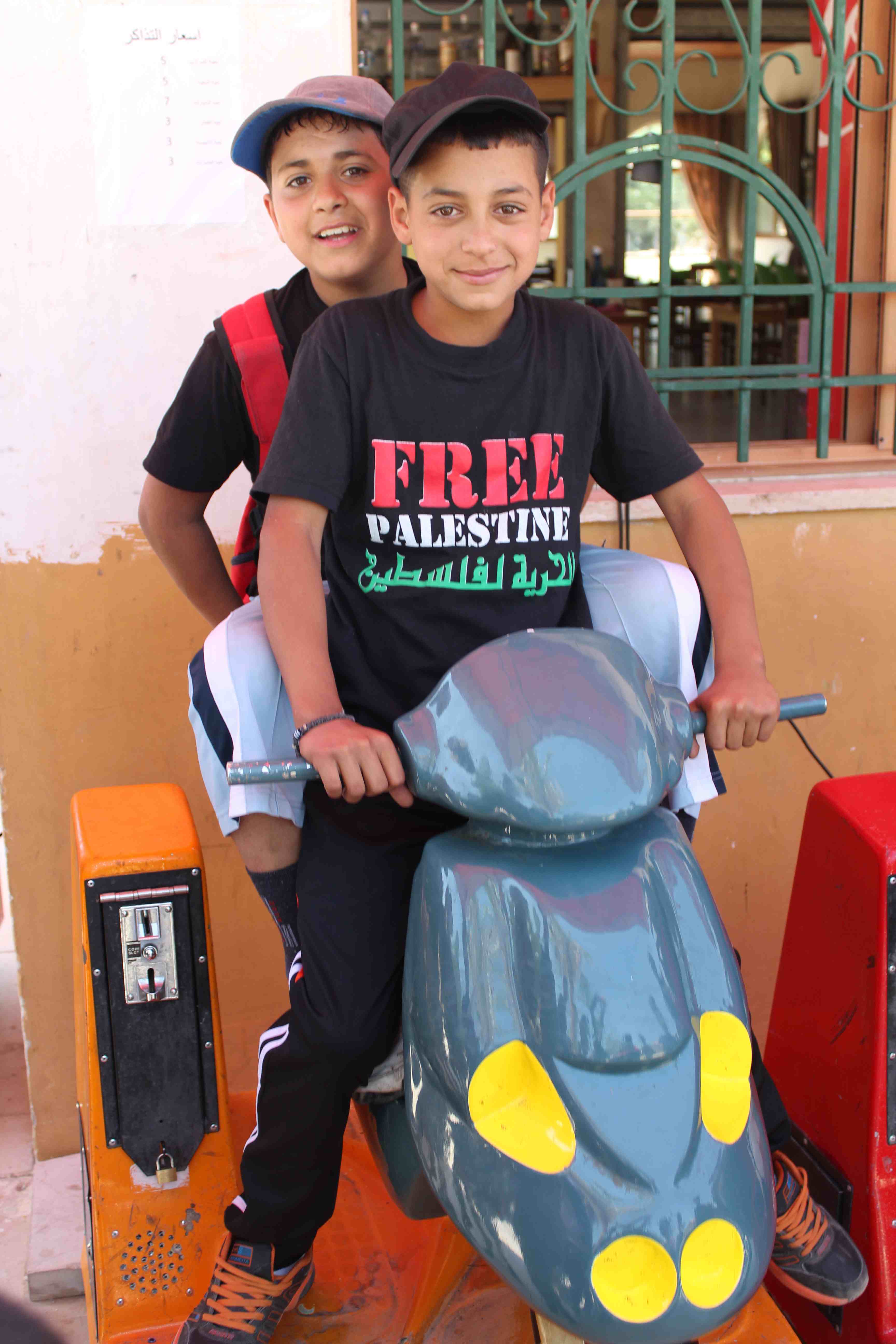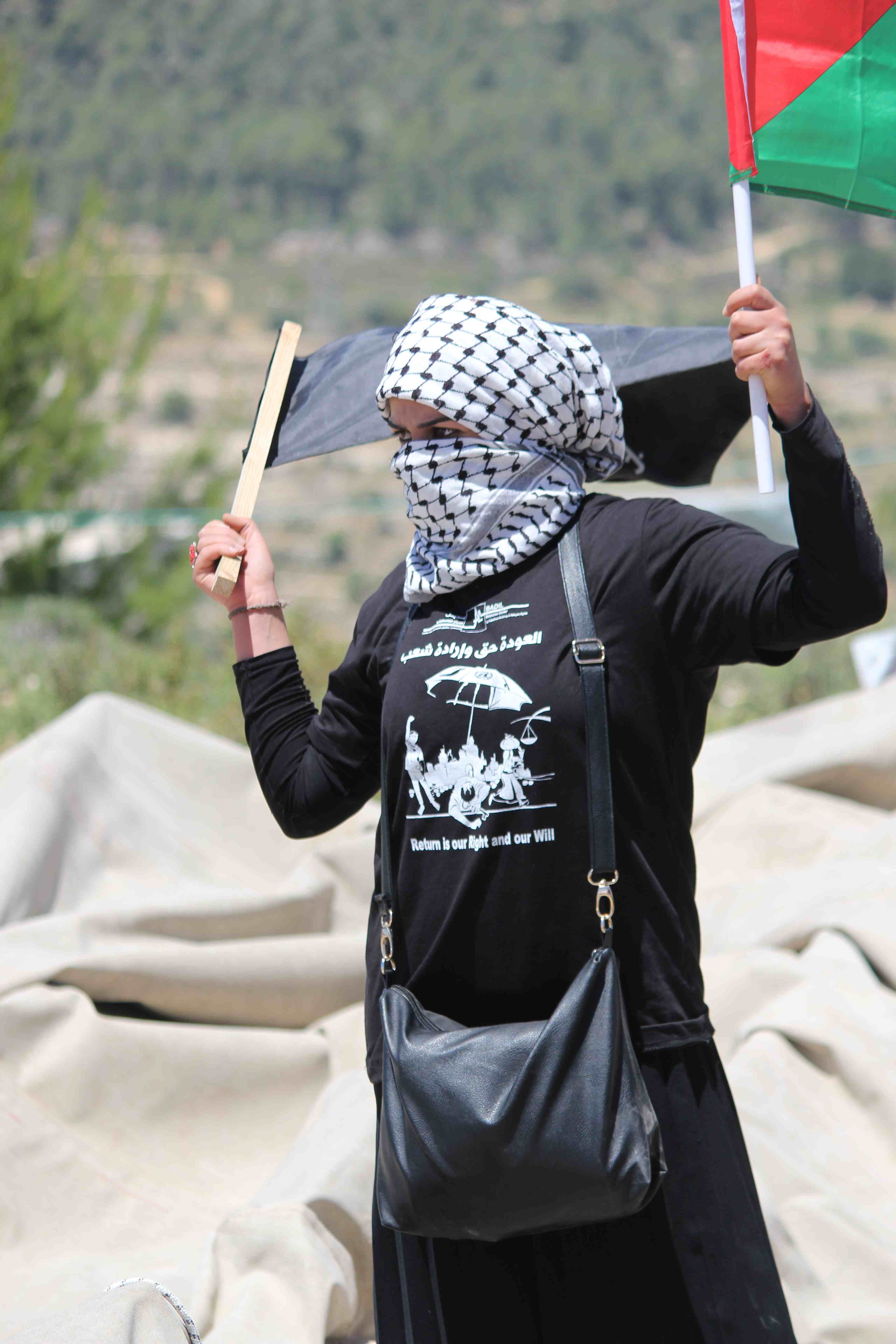Last year around this time, my family and I were in Bethlehem dining with a seasoned American activist when my three-year-old daughter leaned over and whispered in my ear with a fierce intensity: “Tell her about the Nakba!” When I relayed her suggestion to the rest of the table, we all smiled, since this friend knew quite well about the Nakba. The word literally means catastrophe, and it has come to signify Palestinians’ displacement and dispossession at the hands of Zionist militias and then the Israeli army. It turned 750,000 Palestinians into refugees, destroyed more than four hundred villages, and dismantled Palestinian urban life. In fact, my daughter’s impulse was right on: More people need to see the Nakba at the center of the Israeli-Palestinian conflict.
How was it that my young daughter had come to know about the Nakba? From a t-shirt, it seems, or a group of them. As Nakba Day approached, she began to see her father and her mother and so many other people she knew in Bethlehem wearing t-shirts emblazoned with images of families living in tents. Our collective wearing of the same shirt must have been a strange visual transformation for her, given that she experiences the world so much at the level of grownups’ bellies. I was wearing the t-shirt when she asked me, “Is that the Nakba?” Yes, I told her, surprised she knew the word at all. Then she asked me what the Nakba was, and I explained that this was how her grandparents came to live in the refugee camp where they still reside today. She already knew it was not an easy place to live.
These t-shirts, designed each year by Badil, the preeminent Palestinian refugee rights organization, do not only mark history; they also assert rights. On the back of these and many other Palestinian political t-shirts is the number 1948, with “194” in white and “8” in red. 1948 is the year of Palestinian dispossession. 194 is the number of the United Nations Security Council resolution passed in 1948 and reaffirmed virtually every year since that states that Palestinian refugees have a right to return to their homes. The t-shirts send the important message that our rights are connected to our history, and that they are enshrined in international law.
We were in Palestine for four months last summer, spending a lot of time in my husband’s home community of Aida Refugee Camp, Bethlehem. It was a year of many t-shirts. Eid Al-Fitr, the holiday following Ramadan, arrived in the middle of Israel’s bloody attack on Gaza. No one could bear to celebrate. Usually on the morning of Eid all of the children wear fancy new clothes. This year, community members gathered solemnly to paint a mural of the names of children killed in Gaza. Activists in the neighborhood were distributing t-shirts expressing solidarity with Palestinians in Gaza. They came in child and adult sizes.
Soon, the annual summer camp for area children was slated to start, but the war was still raging. Organizers at Lajee Center were pained to reconcile the possibility of our children having fun while children in Gaza were suffering so terribly. On the other hand, the children of Aida had few organized summer activities. They needed a break, not least from the television news itself. So they made a summer camp t-shirt–which usually has an organizational logo or the words “Free Palestine” on it – adorned with a famous line of Mahmoud Darwish’s poetry: “On this land is what makes life worth living.” It was a bold claim in those burning months. When, during the summer camp, we made an alphabet book out of cut paper collage, the children cut out paper clothes (the letter ghayn for ghaseel, or laundry), and they cut out the word “Gaza” in Arabic and the numbers 1948 to paste onto some of the t-shirts.
It was not only in the West Bank that I saw great t-shirts. When I traveled to Jaffa, I delighted in seeing Palestinians wearing t-shirts that said, simply enough, “Falastini” or “Falastiniyya”: “Palestinian” in simple and beautiful Arabic script. Asserting one’s identity and bringing Arabic into Israeli public space is itself an eloquent and courageous form of protest.
.jpg)
[Photo by Mohammad Al-Azza]
T-shirts are a prominent and visible form of everyday politics because they materialize several fundamental and deeply felt truths about politics in Palestine: Our bodies are subjected to overwhelming and arbitrary Israeli state control, with the threat of outright violence looming as close as the nearest watchtower, or checkpoint, or soldier, or settler, or prison, or military base. T-shirts – distributed and worn en mass as these Nakba Day t-shirts were – allow us to speak together and individually.
These t-shirts also allow us to express basic truths over and over again as we move through our day. And repetition is necessary, since Israeli violence is both iterative and cumulative. A key political expression related to the Nakba holds that “Al-Nakba Mustamirra:” The Nakba is ongoing. This is most immediately true in that Palestinian refugees have not been able to return to their lands.
But there are countless other catastrophes, too, on the level of communities: Palestinian displacement in the Naqab (Negev) amounts to what one human rights lawyer has called “another nakba.” This month, setting a dangerous precedent, Israel’s highest court ruled that 700 Palestinians in the village of Umm al-Hiran can be displaced just so a Jewish-only town–to be called Hiran–can be built. The crisis of water access in many Palestinian communities is an “Everyday Nakba,” as a Palestinian filmmaker termed it. Then there are the personal catastrophes: Arrests, solitary confinement, and torture experienced by too many children and adults; a Palestinian family that must experience not only the shooting of a young unarmed man by Israeli police, but also watch as his killers are not held accountable.
For decades, Israel has constricted Palestinians’ potential. They are deprived of cultural and educational institutions; they are physically injured; they are forced to waste time in court for meaningless offenses or no offense at all. They suffer physically and emotionally from the stress of discrimination, dispossession, or military occupation. In terms of outright political violence, the United Nations found that 2014 was the deadliest year for civilians in the Israeli-Palestinian conflict since 1967, with 2,314 Palestinian fatalities, over 2,100 of whom were in Gaza, and eighty-seven Israeli fatalities. And many are simply limited in their dreams. What Palestinian can dream of being a pilot landing a plane in a Palestinian airport? Or having an artwork hang in a Palestinian museum, accessible to all Palestinians?

[Photo by Mohammad Al-Azza]
There is no Palestinian whose life is not in significant ways impinged by some of the multiple forms of Israeli violence, past and present. And so we cannot say it enough: The Nakba is ongoing. We inscribe our history and our rights on our bodies (or at least on our t-shirts) to assert that no dimension of Palestinian society can thrive as long as these nakbas continue. Of course, t-shirts are hardly the primary form of Palestinian expression or resistance. Palestinians bravely march in the streets of places like Haifa and Bil‘in and Aida. They watch human rights films and perform parkour in the rubble in Gaza. They challenge international borders with their feet as they did on the Lebanese and Syrian borders on Nakba Day of 2011. Israeli soldiers shot and killed at least 13 protesters on the border that day. They go on hunger strikes in prison. They create memorial books to hold close places they were forced to leave generations ago. They organize political structures despite their statelessness, and they assert their rights. They confront the Israeli military, sometimes with just rocks in their hands, knowing they could pay with their lives. But t-shirts are symbolic of the way in which, for many Palestinians, both Israeli oppression and Palestinian resistance are woven into the fabric of everyday life.
The last t-shirt of the summer in Aida was printed by youth of the refugee camp. It had a picture of the wall around Aida on one side, and a picture of the Palestinian cartoon Handala on the other. It called for boycott of Israeli goods with the slogan, “Don’t fund your enemy, boycott.” Boycotting Israeli products requires a special effort in the West Bank given that Israel controls all goods that enter and leave the West Bank. The West Bank is a captive market. In reinvigorating the local boycott campaign, these young women and men succeeded in having all of the small shopkeepers in Aida Camp sign a declaration that they would not sell any Israeli goods. When the ice cream truck that sells Israeli ice cream came to Aida, they turned it back.
Aida’s campaign was part of a renewed boycott effort throughout Palestinian communities. In the Galilee, some Palestinians told me that while living in Israel, they could not fully boycott Israeli products. But nevertheless, they made efforts to buy everything they could–milk, vegetables, fruit, bread–from Palestinian producers, even if these producers were very small. They stopped going to all-Jewish towns–towns built with segregationist regulations–to do their shopping.

[Photo by Mohammad Al-Azza]
Commemorations of the Nakba are restricted in Israel. A 2011 law recently held up by Israel’s high court has also made those who support boycott, divestment, and sanctions (BDS) in Israel vulnerable to legal action. This, frankly, is all the more reason to support an academic boycott: Israel is no bastion of free speech. Israeli institutions of higher education are tightly entwined with the Israeli military. The BDS campaign unites the struggles of all Palestinians, calling for the right to return, equality for Palestinians under Israeli law, and an end to military occupation. Supporting the BDS campaign is one thing I can do to work for justice for Palestinians. In this struggle, we must do what we can.
[This post is part of a series of reflections by Palestinian anthropologists on the Nakba. It is being published in partnership with Anthropologists for the Boycott of Israeli Academic Institutions.]